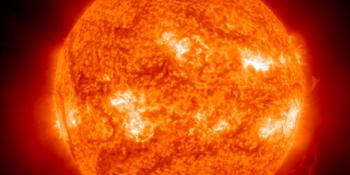Przeglądasz Archiwum z czwartek, 19 czerwca 2003
Raport aktywności słonecznej
Każdy wspomniany rozbłysk słoneczny w tym raporcie ma współczynnik skalowania dodany przez Space Weather Prediction Center (SWPC). Przez skale współczynników SWPC, raporty o rozbłyskach słonecznych są o 42% mniejsze niż naukowo jakościowa data. Skale współczynników zostały usunięte z naszych archiwów o rozbłyskach słonecznych by odzwierciedlić prawdziwe jednostki fizyczne.
Raport aktywności słoneczno- geomagnetycznej 2003 Jun 19 2200 UTCPrzygotowane przez NOAA © SWPC i przetworzone przez SpaceWeatherLive.com
Połączenie raportów USAF/NOAA o słonecznej i geofizycznej aktywności
Numer SDF 170 wydany w 2200Z na 19 Jun 2003IA. Analiza aktywności regionów słonecznych i aktywność od 18-2100Z do 19-2100Z Solar activity decreased to very low levels. Flare
activity was limited to several B-class flares. Region 386 (S07E30)
lost penumbral coverage over the period although it does retain a
delta magnetic structure in the dominant lead spot. Region 387
(N18E49) grew in both penumbral coverage and magnetic complexity
since yesterday, a gamma structure is now evident in the trailing
portion of the spot group. Newly numbered Region 388 (S03E08)
produced a minor B-class flare early in the period.
IB. Prognoza aktywności słonecznej
Solar activity is expected to be at
moderate levels. Region 386 remains capable of producing an
isolated major flare.
IIA. Podsumowanie aktywności geofizycznej 18-2100Z do 19-2100Z
The geomagnetic field was at predominantly active levels today.
Minor storm conditions were observed at both middle and high
latitudes between 19/0000 and 0300Z due to the influence of a
recurrent high speed coronal hole stream. The greater than 10 MeV
proton flux exceeded event threshold at 18/2050Z (reached a max of
24 pfu at 19/0450Z), ended at 19/1900Z and after careful review the
event is believed to have been the result of the M6.8 x-ray flare
from June 17. The greater than 2 MeV electron flux reached moderate
levels today.
IIB. Prognoza aktywności geofizycznej
The geomagnetic field is
expected to be at predominantly unsettled to active levels through
the interval. Minor storm conditions may exist due to a transient
passage during the first half of day one in response to the M6.8
x-ray flare from June 17.
III. Prawdopodobieństwa zdarzenia 20 Jun do 22 Jun
| Klasa M | 50% | 50% | 50% |
| Klasa X | 15% | 15% | 15% |
| Proton | 25% | 15% | 15% |
| PCAF | green | ||
IV. Przepływ 10,7 cm z Penticton
Zaobserwowano 19 Jun 123 Przewidywane 20 Jun-22 Jun 125/125/125 Średnia z 90 dni 19 Jun 124
V. Indeks geomagnetyczny A
Zaobserwowano Afr/Ap 18 Jun 036/054 Szacowane Afr/Ap 19 Jun 023/025 Przewidywane Afr/Ap 20 Jun-22 Jun 020/025-020/025-012/020
VI. Prawdopodobieństwa aktywności geomagnetycznej 20 Jun do 22 Jun
| A. Średnie szerokości geograficzne | |||
|---|---|---|---|
| Aktywne | 40% | 40% | 25% |
| Słaba burza | 15% | 15% | 10% |
| Bardzo znacząca burza | 10% | 10% | 05% |
| B. Wysokie szerokości geograficzne | |||
|---|---|---|---|
| Aktywne | 50% | 50% | 40% |
| Słaba burza | 20% | 20% | 15% |
| Bardzo znacząca burza | 10% | 10% | 10% |
Wszystkie czasy w UTC
<< Idź do codziennego przeglądu
Najnowsze wiadomości
Najnowsze wiadomości z forum
AR 3959 14IP cameras for sky surveillance 41Comet C/2024 G3 (ATLAS) in LASCO C3 10Unspecified geomagnetic activity 1836Filaments and prominences 612
Więcej tematówWesprzyj SpaceWeatherLive.com!
Wielu ludzi odwiedza SpaceWeatherLive aby śledzić aktywność słoneczną lub sprawdzić czy jest szansa na zaobserwowanie zorzy polarnej. Niestety, większy ruch na stronie oznacza większe koszty utrzymania serwera. Dlatego, jeśli jesteś zadowolony ze strony SpaceWeatherLive, zachęcamy do wspierania nas finansowo. Dzięki temu będziemy mogli utrzymać naszą stronę.

Fakty na temat pogody kosmicznej
| Ostatnie rozbłyski klasy X | 2025/01/04 | X1.85 |
| Ostatnie rozbłyski klasy M | 2025/01/09 | M1.1 |
| Ostatnia burza geomagnetyczna | 2025/01/04 | Kp5 (G1) |
| Dni bez plam słonecznych | |
|---|---|
| Ostatni dzień bez skazy | 2022/06/08 |
| Średnia miesięczna liczba plam słonecznych | |
|---|---|
| grudnia 2024 | 154.5 +2 |
| stycznia 2025 | 140.8 -13.8 |
| Ostatnie 30 dni | 151.7 +34.3 |


